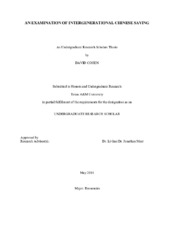| dc.description.abstract | While China has traditionally had exceedingly high saving rates over generations, there has been
a current trend towards a remarkable decrease in this tendency. The theory behind life cycle
savings models suggests that as China faces more exposure to open-market situations, the resulting
changes in China’s spending habits will drive trends towards an overall saving rate level that is
more similar to that of Western countries.
For decades, Chinese citizens have been exposed to luxury products and other conditions that have
changed the cultural attitude towards saving and created a phenomenon in which the younger
Chinese have a drastically less frugal lifestyle than their older counterparts.
In order to determine whether the younger citizens have had an impact on China’s saving as a
whole, this paper will employ the concepts supporting the aforementioned Life Cycle Hypothesis
Models. By examining different data from 2011’s China House Financial Survey (CHFS) and
examining the participants’ responses and their relationship to several factors of interest as well as
the saving rates for nations of similar size and influence, the changes spurred by the newer
generations of Chinese become clear.
2
Generally, the results of the study provide two conclusions. First, despite the shift in cultural
attitude towards spending, China as a whole is still strongly entrenched in consuming not nearly
as much as the West. In fact, the saving rates remain consistently above 50%. Furthermore, while
the overall saving level may not be diminishing quite as dramatically as expected, there is evidence
to suggest that it is starting to increase at a lower rate. Currently, the large majority of the survey
participants still hold the older Chinese standards of high saving and low consumption.
Nevertheless, as more of the risk-taking individuals start to join the workforce, the overall trend presented by CHFS’ data should change, presenting much higher rates of consumption and moving the nation’s Life Cycle Saving Curve (as expected in the theory of the model) to a level similar to
that of many developed Western nations. | en |


